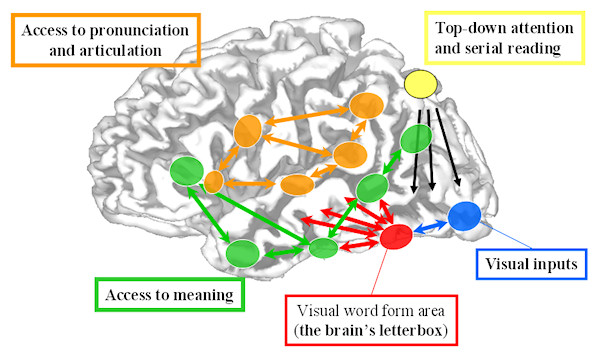Pages in Section 1
What causes dyslexia?
A profile of dyslexia is neurobiological or brain-based. In other words, the brain functiohens differently from the brain of children and adults without dyslexia.
This statement is now absolutely indisputable due to hard evidence. Modern powerful techniques of brain-imaging allow us not only to take images of any part of the brain, but also to locate which regions of the brain are activated during reading or other activities. These have complemented information from earlier studies which detected different aspects of growth and organization in brains of people with dyslexia compared to people without dyslexia.
This ever-growing body of evidence shows without any doubt that children and adults with dyslexia activate other regions of their brain when reading compared to children and adults without dyslexia when reading under the same circumstances.
The causes, as well as the exact nature of these differences, are however still unclear.
What we can say with certainty is that, because ‘Dyslexia is not a single category but a [profile] found within a spectrum of [challenges]’ (Professor Maggie Snowling, University of York, UK), and because the each profile is unique, there is no single cause of dyslexia. Studies present diverse patterns of development and function within this population.
There are numerous hypotheses about why the brains of people with dyslexia develop and function differently.
One hypothesis is that one or several of the numerous connections and paths that are necessary for reading are not functioning optimally or stimulated optimally. Professor Stanislas Dehaene’s diagram below presents, as he stresses himself, a very simplified model of how many complex pathways are needed for reading even a single word:

Challenges may arise if any one of these pathways, or brain areas connected by these pathways, is not working efficiently. h
The PDF (4.4Mb ![]() ) below presents more detailed information as presented by Professor Dehaene during an online conference organised by Dyslexia International:
) below presents more detailed information as presented by Professor Dehaene during an online conference organised by Dyslexia International:
Another complementary hypothesis is that the neurons which form the pathways between the brain areas involved in reading have not developed and navigated to their exact normal destination because of a faulty genetic coding.
Shortcomings in brain development could arise from insufficient nutrition, auto-immunity, environmental impact, or other causes.
In sum, there is no question that significant differences exist between the development and functioning of the brains of people with and without dyslexia, even if the exact causes of these differences are questioned.
The fact that the brains of children/adults with dyslexia work differently may lead to other ways of perceiving, understanding, and thinking. When referring to people with dyslexia, many use the expression thinking outside the box. This will often be reflected in creative, unconventional, and sometimes superior abilities.
Some researchers and practitioners explain that the differences between the brains of people with and without dyslexia merely represent different facets of neurodiversity, which is inherent in human nature. This is the current preferred argument.
More about causes
Genetic factors
Research evidences that most forms of dyslexia are inherited. Studies of identical twins indicate closer similarities on their scores for reading and writing than non-identical twins of the same gender.
In the same family, if one of the members has dyslexia, there is a 50 % likelihood that one of their close relatives would also be dyslexic. However, this does not mean that the two persons will display the same traits of dyslexia, or that their dyslexia will have the same degree of severity.
Experts disagree about the relative prevalence of dyslexia amongst boys and girls. Up to the end of the last century, the ratio was thought to be four (4) boys to one (1) girl. Research then challenges this ratio to one-to-one, with some studies concluding 1.4-1. Such findings are also affected by the fact that dyslexia is simply more often diagnosed in boys than in girls due to behaviour as well as verbal development. From a practical point of view, professionals should not be biased by gender ratio. Currently it is more accepted that there are no gender differences in neurodiverse profiles.
Cerebral factors
Modern brain-imaging studies evidence that the brains of children with dyslexia may develop in different ways. Most striking and observed practically in all studies is relatively less activity in a specialized part of the brain, usually in the left hemisphere, when one attempts to read. Therefore the marked asymmetry between the cerebral hemispheres seen in people without dyslexia is not observed in people with dyslexia.
More precisely, most studies conclude under-activity in two regions of the left temporal area:
- the lateral temporal (side-middle) cortex manages the representation of the spoken language (sounds and words) – phonological representations
- the temporal area lower down that is part of a lower visual pathway and which is close to the occipital cortex at the back of the brain and deals with vision
These observations support the theory of a double deficit: visual and phonological. In brief, in the brains of people with dyslexia, several key areas may not be sufficiently activated at both the level of visual analysis and phonological processing.
To observe the abnormal under-activity of this part of the brain in people with dyslexia, researchers have also examined anatomical or physical organization. They use a technique which microscopically images layers of parts of the cortex. It shows that in the case of people with dyslexia there appears to be some disorganization in the left temporal region. This disorganization arises because some neurons are not in their right place.: either because they have stopped migrating to their correct final destination during the development of the brain, or because they have partially migrated to the wrong places. These sites are called ectopias.
A technique which can give images of activity in the long-distance connections, called the fascicles, between areas of the brain, shows there is also a degree of disorganization in some of these tracts.
Other factors
Nutritional factors during the pregnancy of the mother, and in the early childhood of the infant, as well as immunological resistance in the foetus, are implicated. With regard to nutritional factors in the growing child, there may be a lack of a key fatty acid which is essential for the formation of the membranes of the nerves.
Problems do not always lie solely in the cerebral cortex. The brain has to control the fine tracking of the central most sensitive part of the eye when reading. One of the several pathways from eye to cerebral cortex, composed of the magnocellular nerves which speedly deal with the detection of light and movement, and hence motor response, may also be impaired. Similarly, magnocellular auditory pathways may be compromised and this would affect sensitivity to sound. Ultimately, these factors would affect the speed of processing which is instrumental in integrating the information from our senses and coordinating behaviour.
There is evidence that other subcortical structures affect. For example, the cerebellum (also referred to as the little brain, part of the hindbrain) is implicated because they are instrumental in the fine control of movement, automaticity, and even memory and retrieval. Another subcortical set of structures, called the basal ganglia, could also be implicated because they deal with the initiation and suppression of movement.
Some children are excessively sensitive to certain wavelengths of light. Reading is therefore physically distressing. This is also at times considered as Visual Stress.
For an overview of many of these factors, and the magnocellular theory in particular, do a search for Professor John Stein of Oxford University, who is Chairman of Dyslexia International’s Scientific Advisory Committee. For the effect colour, black and white enviornments and regularity of lines in the environment, do a search for Professor Arnold Wilkins of the University of Essex for the use of colorimetry and visual stress.
Conclusions
These brief notes reveal the complexity of the issue.
A person may present a few or many of the deficits to a greater or lesser extent. Dyslexia will then manifest itself in different ways and in different degrees.
There are two important messages:
- for the time being, an open mind on the causes of the many types of dyslexia is prudent
- more practically, during your teaching experience, you will come to appreciate the neurodiversity of all your children and the particular types of diversity displayed in children with dyslexia.


